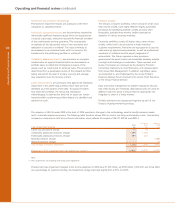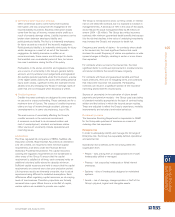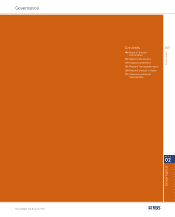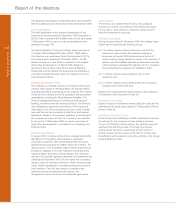RBS 2005 Annual Report Download - page 106
Download and view the complete annual report
Please find page 106 of the 2005 RBS annual report below. You can navigate through the pages in the report by either clicking on the pages listed below, or by using the keyword search tool below to find specific information within the annual report.
104
Operating and financial review
Operating and financial review continued
Claims management risk
Claims management risk is the risk that claims are paid
inappropriately. Claims are managed using a range of IT
system controls and manual processes conducted by
experienced staff, to ensure that claims are handled in a timely
and accurate manner. Detailed policies and procedures exist
to ensure that all claims are handled appropriately, with each
member of staff having a specified handling authority. The
processes include controls to avoid claims staff handling or
paying claims beyond their authorities, as well as controls to
avoid paying invalid claims. Loss adjustors are used to handle
certain claims to conclusion.
Reinsurance risk
Reinsurance is used to protect the insurance results against
the impact of major catastrophic events or unforeseen volumes
of, or adverse trends in, large individual claims and to transfer
risk that is outside the Group’s current risk appetite.
The following types of reinsurance are used where appropriate:
•Excess of loss ‘per individual risk’ reinsurance to protect
against significantly large individual losses.
•Excess of loss catastrophe ‘event’ reinsurance to protect
against major events, for example, windstorms or floods.
•Quota share reinsurance to protect against unforeseen
adverse trends, where the reinsurer takes an agreed
percentage of premiums and claims.
•Other forms of reinsurance may be utilised according to
need, subject to approval by senior management or the
board as appropriate.
Reinsurance is only effective when the counterparty is
financially secure. Before entering a contract with a new
reinsurer, it must satisfy the Credit Risk Approval process
that uses information derived internally and from security
ratings agencies. Acceptable reinsurers are rated at A-
or better unless specifically authorised by the RBS Insurance
Group Board.
Reserving risk
Reserving risk relates to both premiums and claims. It is the
risk that reserves are assessed incorrectly such that
insufficient funds have been retained to pay or handle claims
as the amounts fall due, both in relation to those claims
which have already occurred (in relation to the claims
reserves, including claims handling expense reserves)
or will occur in future periods of insurance (in relation to the
premium reserves).
a) Premium reserves
In respect of premium reserves, it is the Group’s policy to
ensure that the net unearned premium reserves and
deferred acquisition costs are adequate to meet the
expected cost of claims and associated expenses in relation
to the exposure after the balance sheet date. To the extent
that the unearned premium reserves and deferred
acquisition costs are inadequate, a liability adequacy
provision will be held which will initially write down any
deferred acquisition asset held. Once any deferred
acquisition asset has been exhausted, an additional liability
adequacy provision will be established.
b) Claims reserves
It is the Group’s policy to hold undiscounted claims reserves
(including reserves to cover claims which have occurred but
not been reported (IBNR reserves)) for all classes at a
sufficient level to meet all liabilities as they fall due, having
regard to actuarial estimates and the volatility observed and
expected in the claims in each class.
The Group’s policy is to hold provisions for the major classes of
business in excess of the actuarial best estimate. The
percentage margin in excess of this estimate is assessed by
senior management, with particular reference to the volatility
observed and expected in the claims in each class.
The Group’s focus is on high volume and relatively
straightforward products, for example home and motor. This
facilitates the generation of comprehensive underwriting and
claims data, which is used to monitor and accurately price the
risks accepted. This attention to data analysis is reinforced by
tight controls on costs and claims handling procedures.
Frequency and severity of specific risks and
sources of uncertainty
Most general insurance contracts written by the Group are
issued on an annual basis, which means that the Group’s
liability extends for a 12 month period, after which the Group is
entitled to decline or renew or can impose renewal terms by
amending the premium or excess or both.
The following paragraphs explain the frequency and severity of
claims and the sources of uncertainty for the key classes that
the Group is exposed to:
a) Motor insurance contracts (private and commercial)
Claims experience is quite variable, due to a wide number
of factors, but the principal ones of these are age of driver,
type of vehicle and use.
There are many sources of uncertainty that will impact the
Group's experience under motor insurance, including
operational risk, reserving risk, premium rates not matching
claims inflation rates, the social, economic and legislative
environment and reinsurance failure risks.
b) Property insurance contracts (residential and commercial)
The major causes of claims for property insurance are theft,
flood, escape of water, fire, storm, subsidence and various
types of accidental damage.
The major source of uncertainty in the Group’s property
accounts is the volatility of weather. Weather in the UK can
affect most of the above perils. Over a longer period, the
strength of the economy is also a factor. There are many
other sources of uncertainty which include operational,
reserving and reinsurance issues.
























